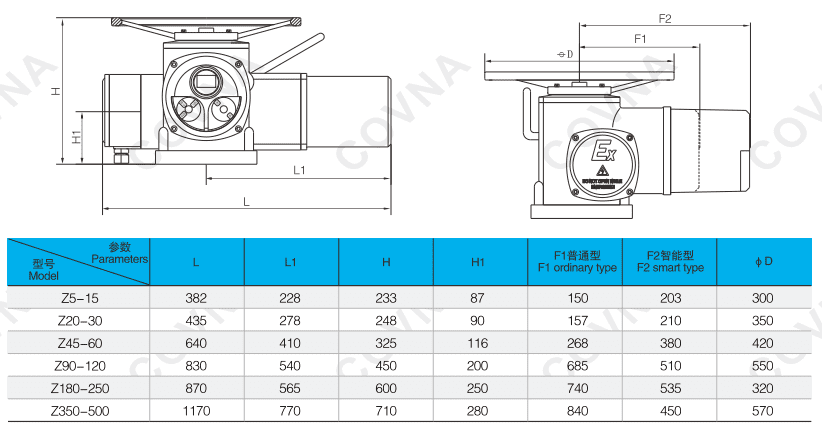COVNA Products


COVNA Liner Knife Gate Valve Multi-turn Electric Actuator
COVNA multi-turn electric actuator, aluminum alloy body construction. Adjustable degree from 0-90 degree. Manual override is available. Torque range is 50Nm to 5000Nm. Nominal voltage : 380V. Motor power: 0.12KW-15KW. Service environment: -40 ℃ – 80 ℃. Maxium diameter of valve stem(mm): 28~80mm. Multi-turn actuators are used for the actuation of valves having linear movement, like gate valves, knife-gate valves, globe valves, diaphragm valves and penstocks
- Model: COVNA-ZD
- Size Range: ZD30 to ZD250
- Pressure Range: 1.0 to 6.4MPa
- Material: Aluminum Alloy
COVNA Multi-Turn Motorized Gate Valve Actuator Features:
This multi-turn electric actuator offers a torque range of 50N·m to 5000N·m, housed in a rugged Type 4X weatherproof aluminum alloy enclosure. It operates reliably within an ambient temperature range of -20℃ to 60℃, with special configurations available for -60℃ to 80℃. Equipped with a heavy-duty motor featuring overload protection, it can handle relative humidity up to 95% at 25℃. The actuator supports various power supplies, including single-phase 220V, three-phase 380V (50Hz), DC24V for long-distance control, and optional single-phase 110V or three-phase 415V/660V (50Hz). Its standard working time is 10 minutes, with customized options extending to 15-60 minutes.
Multi-turn Actuator Main Techincal Specifications:
| Input Signal | 4mA~20mA, Passive contact |
| Power Supply | Conventional: three-phase, AC380V(50Hz)
Special: Three Phase: AC660V, AC440V, AC415V(50Hz, 60Hz) Simplex: AC220V, AC110V(50Hz, 60Hz) Direct: DC12V, DC24V, DC48V |
| Basic error limit | ≤1% |
| Protection class | IP65, IP68…… |
| Explosion-proof grade | Exdll BT4, Exdll CT4 |
| Ambient temperature | ≤95%(25℃) |
| Environmental humidity | -30℃~+70℃(Optional: -40℃~+100℃) |
| Motor working system | Standard long-term, F-class insulation |
Dimension Of Multi-Turn Electric Actuator:
Suitable for gate valve, globe valve, ball valve, and butterfly valve:
Types of Multi-turn Electric Actuator:
COVNA provides four different multi-turn actuators: regulation, on/off, ordinary, and explosion-proof types which are waterproof and can be set with manual override. These multi-turn actuators are used in power plants, oil and gas fields, water treatment, chemical and pharmaceutical industries, ships, and marine vessels.
The actuator on my automated valve operates, but the valve won’t turn. Why?
Most likely the valve stem or actuator coupling is broken.
Why doesn’t my valve open or close completely when the actuator operates it?
The electric actuator limit switches or the pneumatic actuator position stops are not correctly adjusted.
When I energize the solenoid on my pneumatic actuated valve, the valve won’t turn. How come?
Probably because there is no air pressure to the solenoid or dirt has jammed it. Also, debris might be trapped inside the valve. Or, the air pressure is not sufficient to operate the actuator. Remember: measure air pressure at the actuator, not at the compressor.
Can I buy an actuator from one manufacturer and mount it to a valve from another manufacturer?
Maybe. First, be sure that the actuator torque output is sufficient to turn the valve reliably. Second, you will have to fabricate a custom mounting bracket and coupling to connect the actuator to the valve.
What happens if I lose power to my electric actuator in the middle of an actuation cycle?
The valve will stop somewhere between full open and close. When power is reapplied to the original circuit, the actuator will complete the cycle.
I ordered a fail open pneumatic actuated valve by mistake. I needed a fail closed one. What can I do?
To make the change just remove the actuator from the valve and turn it, or the valve stem, 90 degrees and remount the actuator.
I’ve installed my automated valve in the line, but now I don’t know if the valve is in the open or closed position. How can I find out?
Remove the actuator from the valve and check the valve stem. Most ball valves have stem flats at right angles to the flow when the valve is in the off position. On butterfly valves check the stem flow arrow marking.
Do I have to have the solenoid valve that controls the air supply to my pneumatic actuator mounted right on the actuator?
Remove the actuator from the valve and check the valve stem. Most ball valves have stem flats at right angles to the flow when the valve is in the off position. On butterfly valves check the stem flow arrow marking.
How do I wire up my electric actuator?
Check the electric wiring schematic that came with the actuator for the correct hookup. Sometimes a copy is inside the actuator cover. If it is missing, don’t guess about the connections. Call the manufacturer for a schematic.
I’ve just installed an electric actuated valve and when I power it, it turns the valve 360 degrees and won’t shut off. What’s wrong?
The actuator is wired incorrectly (check the schematic accompanying the actuator), or the external control switch is not the correct type for the actuator.
My electric actuators cycle time is way too fast, can I slow it down?
Not unless you bought it with an optional speed control.
I just replaced a solenoid valve with an electric actuated valve and it won’t work. Why?
Actuators and solenoid valves require different types of electrical control switches. SPDT for actuators, SPST for solenoids. Check the actuator wiring schematic for the correct wiring and switch type.















